Largest Iron Age gold coin hoard 'one of a kind'
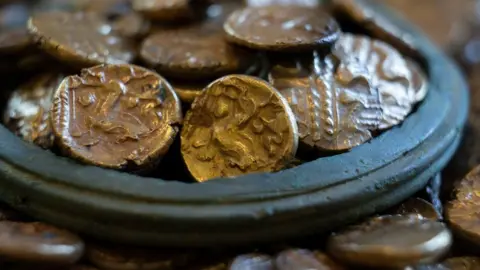 Fountain Media
Fountain MediaA "one-of-a-kind" cache of 933 Iron Age gold coins whose finder was convicted of attempted theft is to go on permanent display close to where it was discovered.
The Great Baddow Hoard, which was found in 2020, is a "nationally significant" find because it is Britain's largest recorded Iron Age gold coin hoard, according to experts.
It was declared treasure by a coroner and has been acquired by the Museum of Chelmsford, Essex, after receiving a £250,000 National Lottery Heritage Fund grant.
Curator Claire Willetts said it "could have been intended as a tribute payment to Roman general Julius Caesar".
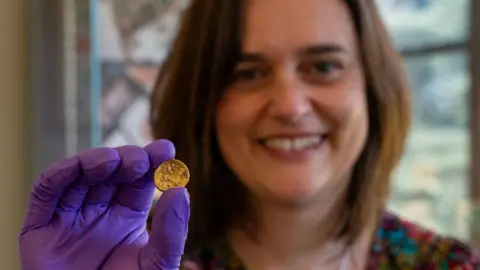 Fountain Media
Fountain MediaThe hoard come from a time when Iron Age tribes first began minting their own coins using regional dies (metal stamps) and it was found with fragments of a possible container or vessel.
It is the first archaeological evidence of aggression between two neighbouring Iron Age tribes, Trinovantes and Catuvellauni, said the museum's curator, Claire Willetts.
"The hoard's discovery in what is traditionally considered Trinovantian territory at Great Baddow may indicate movement or influence from western tribal groups into the east, potentially aligning with accounts of upheaval during Caesar's second invasion of Britain in 54 BC," she said.
Previously, the only evidence of this was in Roman sources.
Essex finds liaison officer Lori Rogerson described it as "a nationally significant discovery".
"In the coming years, visitors seeing the hoard at the Museum of Chelmsford will be in awe at its size and gold content and they'll be led to ask questions such as, 'Who owned such a large stash of precious coins?' and, 'Why was it put in the ground, never to be returned to?'", she said.
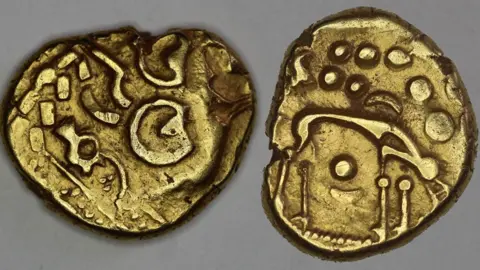 Trustees of the British Museum
Trustees of the British MuseumHaving remained in the earth for more than 2,000 years, a metal detectorist found the collection on private land, but he had not sought permission to detect there.
Shane Wood admitted the theft of 22 Staters and one quarter Stater, and failing to notify the coroner of the find under the Treasure Act 1996 at Chelmsford Magistrates' Court in April 2021.
As well as fines, he had his metal detector destroyed.
Having initially failed to declare the find under the Treasure Act, his actions meant the potential to understand its archaeological context was limited.
The British Museum's independent Treasure Valuation Committee recommended Wood should not receive a reward, so only the landowner was rewarded for the find.
The law and metal detecting
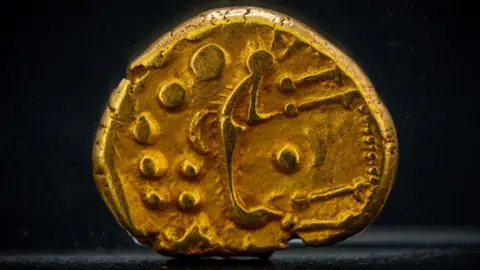 Fountain Media
Fountain Media- No search can begin until permission has been given by the landowner
- All finds belong to the landowner
- Any find in England, Wales and Northern Ireland that is more than 300 years old, made of gold or silver, or found with gold or silver artefacts, could be treasure under the 1996 Treasure Act
- These must be reported to the appropriate county finds liaison officer
Source: Portable Antiquities Scheme
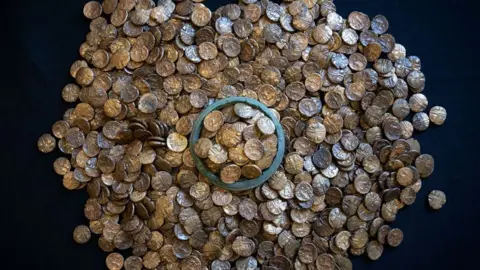 Fountain Media
Fountain MediaJennie Lardge, Chelmsford City Council's cabinet deputy for cultural services, said: "I hope many of our residents, especially those in Great Baddow, will feel as I do, an immense pride in this outstanding piece of Britain's history uncovered here in Chelmsford."
The city council, Friends of Chelmsford Museums, Essex Society for Archaeology and History, Essex Heritage Trust, Council for British Archaeology East, and Essex Numismatics Society were among those who also contributed funds so the museum could acquire the find.
Liz Bates, director of England, Midlands & East at the The National Lottery Heritage Fund, which provided the bulk of the funds, said it was pleased to support the acquisition of "this one-of-a-kind Iron Age hoard".
It will go on display at the museum in summer 2026.
 Fountain Media
Fountain MediaFollow Essex news on BBC Sounds, Facebook, Instagram and X.
